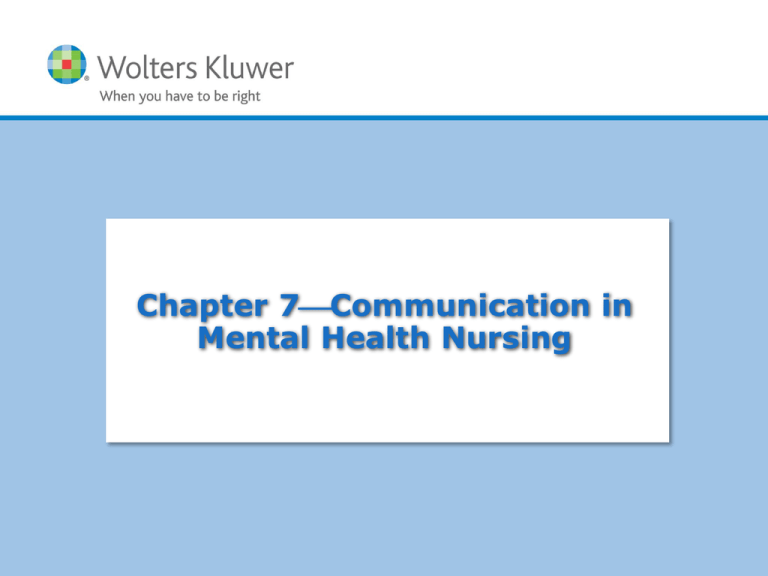
Chapter 7Communication in
Mental Health Nursing
• Open class with s/s
• Dress/act the part?????
• Nursing care?
• Communication techniques
• Medications
• Labs
•
• Movie occasionally---you tube
•
• Student group presentations on several disease process
•
• Pictures???/
•
Copyright © 2016 Wolters Kluwer • All Rights Reserved
Communication in Mental Health Nursing
• Communication
– Process of exchanging information involving
• Person; person receiving message; message itself
– Verbal: communication using words
• Speaking, writing, reading, listening
– Nonverbal: communication without words
• Body language, space, touch
• Nursing communication: purposeful; centered on
client needs, problems
Copyright © 2016 Wolters Kluwer • All Rights Reserved
Communication in Mental Health
Nursing (cont.)
• Speech patterns common to clients with mental
illness
– Blocking: loses train of thought; stops speaking
because of unconscious block
• “Then my father…what was I saying?”
– Circumstantiality: cannot be selective, describes in
over-abundant detail
•
Question: Do you have any physical illness?
•
Reply: My head hurts, my nose has been leaking, my
hair just won’t stay in place, I have this cramping in
my joints…
–
Copyright © 2016 Wolters Kluwer • All Rights Reserved
Communication in Mental Health
Nursing (cont.)
• Speech patterns common to clients with mental
illness (cont.)
– Echolalia: repeats the last word heard over and
over
• “Please wait here” is responded to with “here,
here, here…”
– Loose association: speaks constantly, shifting
between loosely related topics
• “Martha married Jim who is a good cook. I can
cook. Cows are something we can cook. I wonder
why a cow moos?”
Copyright © 2016 Wolters Kluwer • All Rights Reserved
Communication in Mental Health
Nursing (cont.)
• Speech patterns common to clients with mental
illness (cont.)
– Flight of ideas: shifts rapidly between unrelated
topics
• “My cat is gray. The food here is good. My hair
needs a perm.”
– Neologism: coins new words and definitions
• “Hiptomites are real powerful people” in reference
to a husky mental health technician on the unit
Copyright © 2016 Wolters Kluwer • All Rights Reserved
Communication in Mental Health
Nursing (cont.)
• Speech patterns common to clients with mental
illness (cont.)
– Verbigeration: repeats words, phrases, sentences
several times
• Nurse: “It’s time to take your pill”
• Client: “Take your pill, take your pill, take your
pill…”
Copyright © 2016 Wolters Kluwer • All Rights Reserved
Communication in Mental Health
Nursing (cont.)
• Therapeutic communication: interaction between
nurse/team member and client with a specific goal
– Goal: learn about the client and his/her problem
– Planned, directed by nurse
– Use verbal and nonverbal techniques
– Nurse–client relationship influenced by many factors
– Every message filtered by both the sender and the
receiver
Copyright © 2016 Wolters Kluwer • All Rights Reserved
Communication in Mental Health
Nursing (cont.)
• Verbal communication techniques
– Clarification; validation
– Reflection (parroting)
– Restating; focusing
– Using a general lead; giving information
– Using silence
– Exploring alternatives; offering of oneself
– Reinforcing reality
Copyright © 2016 Wolters Kluwer • All Rights Reserved
Communication in Mental Health
Nursing (cont.) start here!!!
• Nonverbal communication techniques
– Intermittent eye contact; congruent facial expression
– Arms and legs uncrossed
– Respecting personal space; use of touch
• Active listening: learned skill
– Observing nonverbal behaviors; analytically listening
to verbal comments
– Listening for/clarifying inconsistencies; attempting to
understand client’s perception of situation
Copyright © 2016 Wolters Kluwer • All Rights Reserved
Communication in Mental Health
Nursing (cont.)
• Nontherapeutic communication: messages, behavior
which hinder the therapeutic process
– Closed body language
– Closed-ended questions
– Nurse: interjecting personal opinions or values
– Minimizing client’s feelings
– Clichés
– Condescending attitude
– Criticism
Copyright © 2016 Wolters Kluwer • All Rights Reserved
Communication in Mental Health
Nursing (cont.)
• Blocks to therapeutic communication: ineffective
responses
– Arguing/disapproving; giving advice
– False reassurance; using the word “why”
– Closed-ended questions; changing the subject
– Agreeing/approving; minimizing/belittling
– Focusing on the nurse
– Stereotype statements
Copyright © 2016 Wolters Kluwer • All Rights Reserved
Question
Which of the following speech patterns is demonstrated
when a client repeats the last word heard?
A.
Echolalia
B.
Flight of ideas
C.
Neologism
D.
Verbigeration
Copyright © 2016 Wolters Kluwer • All Rights Reserved
Answer
A. Echolalia
• Rationale: A client exhibiting echolalia will verbally
repeat the last word that he or she hears.
Copyright © 2016 Wolters Kluwer • All Rights Reserved
Question
Which of the following is NOT an example of therapeutic
communication?
A.
Validation
B.
Using a general lead
C.
Using silence
D.
Closed-ended questions
Copyright © 2016 Wolters Kluwer • All Rights Reserved
Answer
D. Closed-ended questions
•Rationale: Closed-ended questions allow a “yes” or “no”
response without encouraging further information from the
client. These types of questions are a barrier to therapeutic
communication.
Copyright © 2016 Wolters Kluwer • All Rights Reserved
Question
Tell whether the following statement is true or false.
• Therapeutic communication includes both verbal and
nonverbal techniques.
Copyright © 2016 Wolters Kluwer • All Rights Reserved
Answer
True
• Rationale: In the exchange of information between the
nurse and the client, therapeutic communication will
include both verbal and nonverbal techniques.
Copyright © 2016 Wolters Kluwer • All Rights Reserved
Chapter 8Establishing and
Maintaining a Therapeutic
Relationship
The Therapeutic Relationship
• Holistic model of care: person is a unique blend of
biological, psychological, social, and spiritual functioning
– Influences
• Genetics
• Environment
o Internal and external forces
– View of environment is subjective
• Therapeutic relationship: a helping bond where one
person assists in personal growth, well-being of another
Copyright © 2016 Wolters Kluwer • All Rights Reserved
The Therapeutic Relationship (cont.)
• Important characteristics for establishing a nurse–
client relationship
– Empathy; caring
– Acceptance: unconditional positive regard
– Mutual trust; honesty
– Integrity; consistency
– Genuineness; self-awareness
– Limit setting; reassurance
– Explanations
Copyright © 2016 Wolters Kluwer • All Rights Reserved
The Therapeutic Relationship (cont.)
• Phases of a therapeutic relationship
– Orientation: getting to know the client
• Define purpose for interaction; rules + boundaries
– Working stage: outcomes, interventions planned
• Goals developed; appropriate coping skills taught
• Client priorities set
– Termination: allows client to depend on his/her own
strengths while developing improved adaptive skills
• Nurse encourages client independence in relating to
others
Copyright © 2016 Wolters Kluwer • All Rights Reserved
The Therapeutic Relationship (cont.)
• Professional boundaries: spaces between the power of
the nurse and the vulnerability of the client (National
Council of State Boards of Nursing)
– Centered on a condition of helpfulness
– Needs of nurse: distinctly different than needs of client
– Nurse must clarify, enforce boundaries with clients
– Clearly document deviations from standard
– Nurse–client relationship must not extend beyond
therapeutic termination phase
Copyright © 2016 Wolters Kluwer • All Rights Reserved
The Therapeutic Relationship (cont.)
• Professional boundaries (cont.)
– Violations
• Unnecessary personal disclosure by the nurse
• Secrecy; sexual misconduct
• Over-helping
• Controlling
• Role reversal in nurse–client relationship
Copyright © 2016 Wolters Kluwer • All Rights Reserved
The Therapeutic Relationship (cont.)
• Response to difficult client behaviors
– Observe/anticipate behaviors that may require an
immediate or directed response
– Causes
• Personality, character problems
• Response to illness, heightened anxiety levels
– Basic dynamic root: individual response to anxiety
from environment or internal stressors
• High levels of stress
Copyright © 2016 Wolters Kluwer • All Rights Reserved
The Therapeutic Relationship (cont.)
• Manipulation
– Demand for instant gratification
– Lack of self-control
– Nursing approach
• Reinforce consistent limits
• Limits should be fair, explained thoroughly
• Avoid reinforcing negative behavior
• Focus on the client’s feelings
Copyright © 2016 Wolters Kluwer • All Rights Reserved
The Therapeutic Relationship (cont.)
• Violence or aggression
– Take precautionary measures
– Keep safety in mind—for the client and others nearby
– Recognize early signs: de-escalate the behavior
• Communication and calm approach
• Sometimes necessary to withdraw from location
Copyright © 2016 Wolters Kluwer • All Rights Reserved
The Therapeutic Relationship (cont.)
• Altered thought process (hallucinations, illusions,
delusions)
– Basic feeling of the client is fear/mistrust
– Therapeutic encounter
• Explanations that the client can understand
• Genuine concern for client’s discomfort
• Purposeful movements/personal space maintained
• Reestablish the client’s contact with reality
• Focus on client’s current feelings
Copyright © 2016 Wolters Kluwer • All Rights Reserved
The Therapeutic Relationship (cont.)
• Sexually inappropriate behaviors or aggression
– Directly inform the client his/her actions are
unacceptable
• Establish limits
– Proceed to underlying issue with client
– If behavior continues, terminate the session
– Unmanageable situation: consult with supervisor or
colleague
Copyright © 2016 Wolters Kluwer • All Rights Reserved
Question
Tell whether the following statement is true or false.
•The therapeutic nurse–client relationship consists of two
phases: orientation and termination.
Copyright © 2016 Wolters Kluwer • All Rights Reserved
Answer
False
•Rationale: The therapeutic nurse–client relationship
consists of three phases: an orientation phase, a working
stage, and a termination point.
Copyright © 2016 Wolters Kluwer • All Rights Reserved
Question
A consciousness of our own personality and behavior in
response to the world around us is called
A.
Empathy
B.
Self-awareness
C.
Orientation
D.
Genuineness
Copyright © 2016 Wolters Kluwer • All Rights Reserved
Answer
B. Self-awareness
• Rationale: Self-awareness is a knowledge of the self as a
whole person, including individuality and personality.
Copyright © 2016 Wolters Kluwer • All Rights Reserved
Question
Tell whether the following statement is true or false.
• Too much concern or not enough concern can both cross
the limits of professional boundaries.
Copyright © 2016 Wolters Kluwer • All Rights Reserved
Answer
True
• Rationale: There is a delicate balance between knowing
when to help and when not to help. Too much concern or
not enough concern can cross the boundary standards.
Copyright © 2016 Wolters Kluwer • All Rights Reserved






